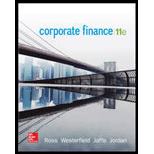
To determine: How much will it cost a person to certain if he or she is elected if they use straight voting and if it uses cumulative voting.
Introduction:
Cumulative voting:
Cumulative voting is a voting method conducted with minority candidates. During cumulative voting, the overall number of votes that every candidate may cast is evaluated. The cumulative voting is compute as the total number of shares owned multiplies by the total number of directors to be elected.
Straight voting:
Straight voting is when a shareholder are entitles to cast one vote per share. These votes are divided equally among the candidates. In straight voting policy, shareholders cannot vote more than one time.
Want to see the full answer?
Check out a sample textbook solution
Chapter 15 Solutions
Corporate Finance (The Mcgraw-hill/Irwin Series in Finance, Insurance, and Real Estate)
- How the Synthesizing Qualitative Research Methodology in Case Study Research can be used in case of the collapse of Circuit City? What cause the Circuit City Failed to Adapt to E-commerce? Why DMAIC, a data-driven problem-solving method, and Lean Six Sigma did not save Circuit City?arrow_forwardHow was the poor strategic decisions lead to economic downturns of Circuit City Company? What are the sequence of key events and problems that contribute to its collapse. Could you please explain each one them? How Lean Six Sigma businesses can reduce waste, improve efficiency, and enhance customer satisfaction?arrow_forwardSuppose you deposit $9500 into an savings account earning 5% annual interest compounded continuously. To pay for all your music downloads, each year you withdraw $1000 in a continuous way. Let A(t) represent the amount of money in your savings account t years after your initial deposit. (A) Write the DE model for the time rate of change of money in the account. Also state the initial condition. dA dt A(0) (B) Solve the IVP to find the amount of money in the account as a function of time. A(t)= (C) When will your money run out? t = yearsarrow_forward
- What support comment would be for the Creating Problem Statements and Applicable Research Questions for Sears collapse? Could explain and show the problem is happening from the perspective of the leader who has the problem in Sears company? How Sear problem would be soved? What are other elements of the problem, could you give some assumptions about the problem, or give recommendations to mitigate the problem?arrow_forwardAn S corporation earns 59.10 per share before taxes. The corporate tax rate is 39%, the personal tax rate on dividends is 15%, and the personal tax rate on non-dividend income is 36%. What is the total amount of earnings after - taxes? a. $3.28 b. $3.93 c. $2.62 d. $4.59arrow_forwardYou want to buy a new sports car from Muscle Motors for $36,000. The contract is in the form of an annuity due for 60 months at an APR of 8.00 percent. What will your monthly payment be?arrow_forward
- Use the following information to answer this question: Net sales Windswept, Incorporated 2024 Income Statement Cost of goods sold Depreciation ($ in millions) Earnings before interest and taxes Interest paid Taxable income Taxes Net income $ 14,150 8,150 515 $ 5,485 108 $ 5,377 1,129 $ 4,248 Windswept, Incorporated 2023 and 2024 Balance Sheets ($ in millions) 2023 2024 2023 2024 Cash Accounts received $ 300 $ 330 Accounts payable $ 1,980 $1,955 1,190 1,090 Long-term debt 1,110 1,430 Inventory 2,120 1,795 Common stock 3,440 3,080 Total $ 3,610 $ 3,215 Retained earnings 690 940 Net fixed assets 3,610 Total assets $ 7,220 4,190 $ 7,405 Total liabilities & equity $ 7,220 $ 7,405 What is the fixed asset turnover for 2024?arrow_forward9. Calculating Payments [LO3] The Bandon Pine Corporation's purchases from suppliers in a quarter are equal to 75 percent of the next quarter's forecast sales. The payables period is 60 days. Wages, taxes, and other expenses are 20 percent of sales, and interest and dividends are $110 per quarter. No capital expenditures are planned. Projected quarterly sales are shown here: Sales Q1 $2,250 Q2 $2,730 Sales for the first quarter of the following year are projected at $2,475. Calculate the company's cash outlays by completing the following: Payment of accounts Wages, taxes, other expenses Long-term financing expenses (interest and dividends) Total Q3 $2,390 Q4 $2,190 Q1 Q2 Q3 Q4arrow_forwardThe average daily net transaction accounts of a local bank during the most recent reserve computation period is $341 million. The amount of average daily reserves at the Fed during the reserve maintenance period is $26.20 million, and the average daily vault cash corresponding to the maintenance period is $5.8 million. (Example13-2). a. Under the rules effective in 2020, what is the average daily reserve balance required to be held by the bank during the maintenance period? b. Is the bank in compliance with the reserve requirements?arrow_forward
- What are the LSS and characteristics of LSS tools used in a research study? What is Lean Six Sigma and what is the possible benefits of using Lean Six Sigma? What are the seven LSS tools, could you please explain the characteristics of each tool, and state how the tool would be used to in a case study? How Lean Six Sigma brings a hint of all three traditional types of research (qualitative, quantitative, and mixed methods) to bear on Case Study research and business solutions?arrow_forwardSelect a real-world case situation. Use this case which you either know about already or have identifiedthrough research and address the following questions in essay format:.i. Outline and discuss what “triggered” the regulatory body to intervene? ii. How effective do you think the response was to such a crisis? iii. Outline and discuss two ways that could be used to strengthen the current regulatoryarrow_forwardle Shema actencial de theophile cautionarrow_forward
 EBK CONTEMPORARY FINANCIAL MANAGEMENTFinanceISBN:9781337514835Author:MOYERPublisher:CENGAGE LEARNING - CONSIGNMENT
EBK CONTEMPORARY FINANCIAL MANAGEMENTFinanceISBN:9781337514835Author:MOYERPublisher:CENGAGE LEARNING - CONSIGNMENT College Accounting, Chapters 1-27AccountingISBN:9781337794756Author:HEINTZ, James A.Publisher:Cengage Learning,
College Accounting, Chapters 1-27AccountingISBN:9781337794756Author:HEINTZ, James A.Publisher:Cengage Learning,



